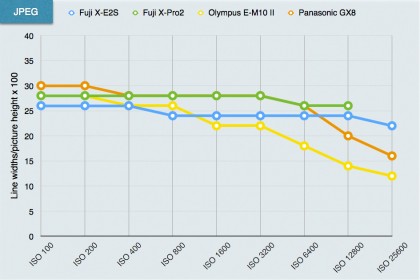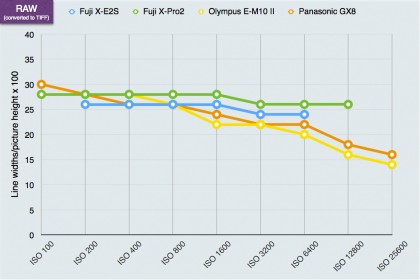Why you can trust TechRadar
We test resolution using an industry standard ISO test chart in laboratory conditions. We check resolution across the camera's ISO range, and for both JPEG and raw files. The figures are quoted in line widths/picture height, which is a measure now widely adopted by image testers as it allows direct comparisons between cameras, even those with different sensor sizes.
This means we can compare new cameras against others in our lab test database, and in our charts we include the results from three key rivals. In this instance, we've chosen three other mirrorless cameras:
• Fuji X-Pro2: This is the latest and best Fuji mirrorless camera and the first to come with Fuji's new 24-megapixel X-Trans sensor – that's a 50% increase in resolution over other Fuji X-mount cameras, including the X-E2S.
• Olympus OM-D E-M10 II: The E-M10 II looks like a miniature DSLR camera rather than a rangefinder design, but its price and performance make it a strong rival to the X-E2S.
• Panasonic GX8: Panasonic also has a new sensor, this time a 20-megapixel Micro Four Thirds sensor used for the first time in the rangefinder-style GX8. This is a smaller sensor format than the APS-C sensor used in the Fuji X-E2S, but the GX8's results are impressive nonetheless.

JPEG resolution analysis: The Fuji X-E2S is a distinctly average performer in this group. Its resolution is good, but it's beaten by both the X-Pro2 and the Panasonic GX8 – perhaps not surprisingly, since they have higher resolution sensors.

Raw (converted to TIFF) resolution analysis: The X-E2S fares rather better when shooting raw files. The X-Pro2 still has a resolution advantage, but it's smaller, and while the Olympus and Panasonic are a little sharper at low ISOs, the X-E2S beats them at ISO 1600 and beyond, probably a reflection of its larger sensor.
